大英百科全书使用指引
- 格式:ppt
- 大小:8.83 MB
- 文档页数:15
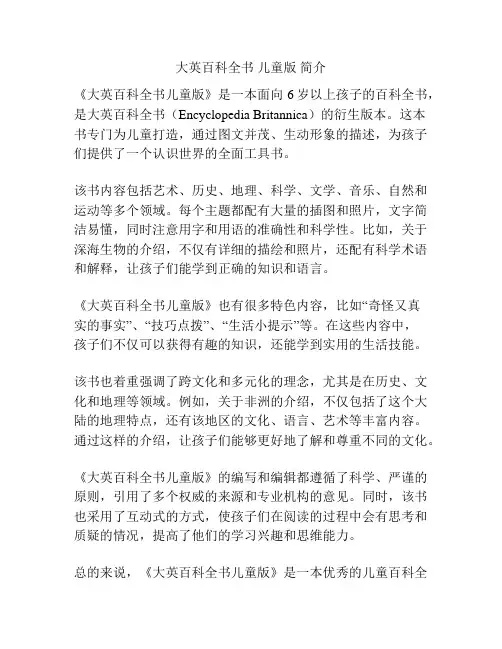
大英百科全书儿童版简介
《大英百科全书儿童版》是一本面向6岁以上孩子的百科全书,是大英百科全书(Encyclopedia Britannica)的衍生版本。
这本
书专门为儿童打造,通过图文并茂、生动形象的描述,为孩子们提供了一个认识世界的全面工具书。
该书内容包括艺术、历史、地理、科学、文学、音乐、自然和运动等多个领域。
每个主题都配有大量的插图和照片,文字简洁易懂,同时注意用字和用语的准确性和科学性。
比如,关于深海生物的介绍,不仅有详细的描绘和照片,还配有科学术语和解释,让孩子们能学到正确的知识和语言。
《大英百科全书儿童版》也有很多特色内容,比如“奇怪又真
实的事实”、“技巧点拨”、“生活小提示”等。
在这些内容中,
孩子们不仅可以获得有趣的知识,还能学到实用的生活技能。
该书也着重强调了跨文化和多元化的理念,尤其是在历史、文化和地理等领域。
例如,关于非洲的介绍,不仅包括了这个大陆的地理特点,还有该地区的文化、语言、艺术等丰富内容。
通过这样的介绍,让孩子们能够更好地了解和尊重不同的文化。
《大英百科全书儿童版》的编写和编辑都遵循了科学、严谨的原则,引用了多个权威的来源和专业机构的意见。
同时,该书也采用了互动式的方式,使孩子们在阅读的过程中会有思考和质疑的情况,提高了他们的学习兴趣和思维能力。
总的来说,《大英百科全书儿童版》是一本优秀的儿童百科全
书,为孩子们提供了丰富、全面、有趣的知识。
这些知识不仅能够满足孩子们的好奇心,还能够成为他们未来学习和探索世界的基石。
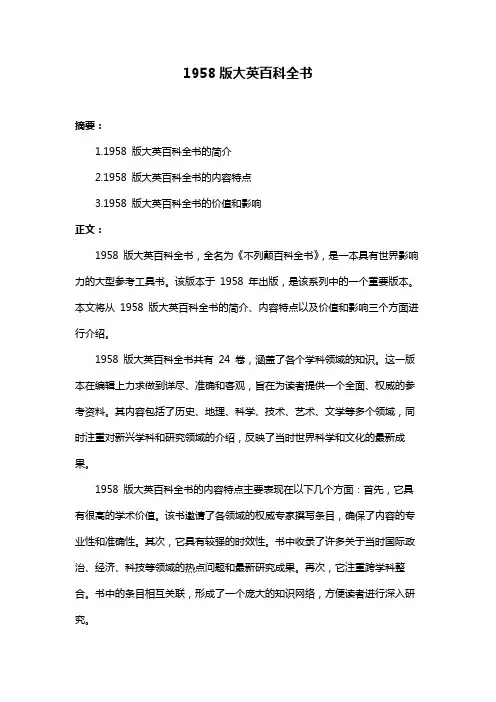
1958版大英百科全书摘要:1.1958 版大英百科全书的简介2.1958 版大英百科全书的内容特点3.1958 版大英百科全书的价值和影响正文:1958 版大英百科全书,全名为《不列颠百科全书》,是一本具有世界影响力的大型参考工具书。
该版本于1958 年出版,是该系列中的一个重要版本。
本文将从1958 版大英百科全书的简介、内容特点以及价值和影响三个方面进行介绍。
1958 版大英百科全书共有24 卷,涵盖了各个学科领域的知识。
这一版本在编辑上力求做到详尽、准确和客观,旨在为读者提供一个全面、权威的参考资料。
其内容包括了历史、地理、科学、技术、艺术、文学等多个领域,同时注重对新兴学科和研究领域的介绍,反映了当时世界科学和文化的最新成果。
1958 版大英百科全书的内容特点主要表现在以下几个方面:首先,它具有很高的学术价值。
该书邀请了各领域的权威专家撰写条目,确保了内容的专业性和准确性。
其次,它具有较强的时效性。
书中收录了许多关于当时国际政治、经济、科技等领域的热点问题和最新研究成果。
再次,它注重跨学科整合。
书中的条目相互关联,形成了一个庞大的知识网络,方便读者进行深入研究。
1958 版大英百科全书的价值和影响深远。
它为全球读者提供了丰富的知识资源,成为了世界各地图书馆、学校和研究机构的重要藏书。
同时,它也影响了后续版本的编撰,为整个百科全书系列的发展奠定了基础。
此外,1958 版大英百科全书的出版还推动了国际间文化交流,增进了世界各地人民对彼此的了解和友谊。
总之,1958 版大英百科全书是一部具有重要历史地位和学术价值的参考工具书。

大英百科全書線上繁體中文版開始歡迎來到大英百科全書線上繁體中文版﹐這裡可讓您查到百科全書裡的資訊。
檢索檢索可以讓您更快地找到百科全書裡的條目。
在每個頁面上都會有一個檢索框,請將檢索詞輸入檢索框。
點按「Go」以確認檢索。
檢索結果將顯示在新的頁面上。
如果您檢索的是百科全書﹐檢索結果將包括檢索到的條目名稱、條目開頭的部分內容﹐以及與該條目相關的其他內容﹐如旗幟、圖像和地圖等。
如果發現了您想要看的條目﹐點按該條目名稱﹐條目內容就會顯示。
如果您還需要更多的幫助,可繼續查看檢索方法提示(Search Tips)中的有關說明。
檢索方法提示這裡有一些辦法可用來改善或修正您的檢索結果。
模糊檢索如果您想檢索一個條目﹐但對詞語的拼法無把握﹐可以使用模糊檢索選項。
選擇此一選項後﹐您會看到同詢問詞對應的一些檢索結果﹐以及同詢問詞具有相似拼法的其他字詞。
同音字檢索如果您想檢索一個條目但不知道其中某個字的準確寫法﹐那就使用同音字檢索選項。
當您選擇這個選項後﹐將會看到對應於您的詢問詞的一些結果﹐以及有相同發音的字詞。
例如﹐檢索「安德生」的結果裡也許會出現「安得生」。
分類檢索如果您想檢索與某個主題有關的一些條目﹐可使用分類檢索選項。
當您從下拉式功能表中選擇了一個類別後﹐將會看到與所選的主題有關﹐與您的詢問詞對應的一些結果。
例如﹐在「音樂」類別上檢索「亞洲」﹐結果顯示的只是與亞洲有關的音樂條目。
在「哺乳動物」類別上檢索「象」﹐結果顯示的是陸地上最大的哺乳動物﹐而若在「遊戲」類別來檢索「象」﹐則得出中國象棋的結果。
用英文檢索條目名稱用中、英兩種文字顯示。
如果您檢索某個特定條目名稱﹐可以用它的中文或英文名稱來檢索。
例如﹐檢索「Internet」將會顯示出「網際網路」的結果。
邏輯檢索您還可以運用如下一些邏輯關條符來改進您的檢索:•如果您希望檢索的條目中同時包含兩個詞組,可以使用“&”(或“and”)符號,比如:法國 & 戰爭;法國 and 戰爭。
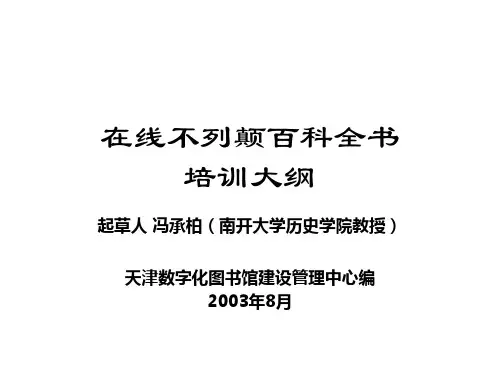

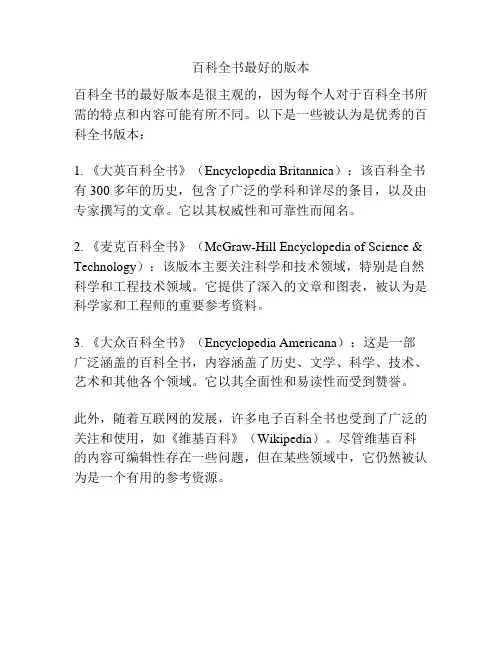
百科全书最好的版本
百科全书的最好版本是很主观的,因为每个人对于百科全书所需的特点和内容可能有所不同。
以下是一些被认为是优秀的百科全书版本:
1. 《大英百科全书》(Encyclopedia Britannica):该百科全书有300多年的历史,包含了广泛的学科和详尽的条目,以及由专家撰写的文章。
它以其权威性和可靠性而闻名。
2. 《麦克百科全书》(McGraw-Hill Encyclopedia of Science & Technology):该版本主要关注科学和技术领域,特别是自然科学和工程技术领域。
它提供了深入的文章和图表,被认为是科学家和工程师的重要参考资料。
3. 《大众百科全书》(Encyclopedia Americana):这是一部广泛涵盖的百科全书,内容涵盖了历史、文学、科学、技术、艺术和其他各个领域。
它以其全面性和易读性而受到赞誉。
此外,随着互联网的发展,许多电子百科全书也受到了广泛的关注和使用,如《维基百科》(Wikipedia)。
尽管维基百科的内容可编辑性存在一些问题,但在某些领域中,它仍然被认为是一个有用的参考资源。
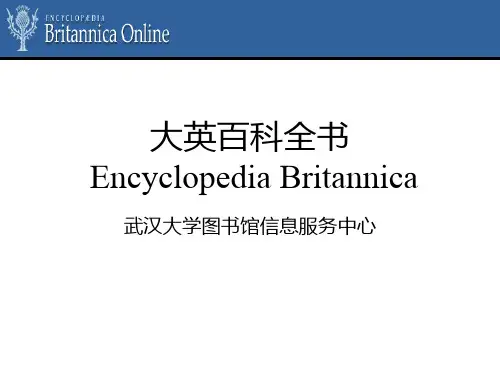
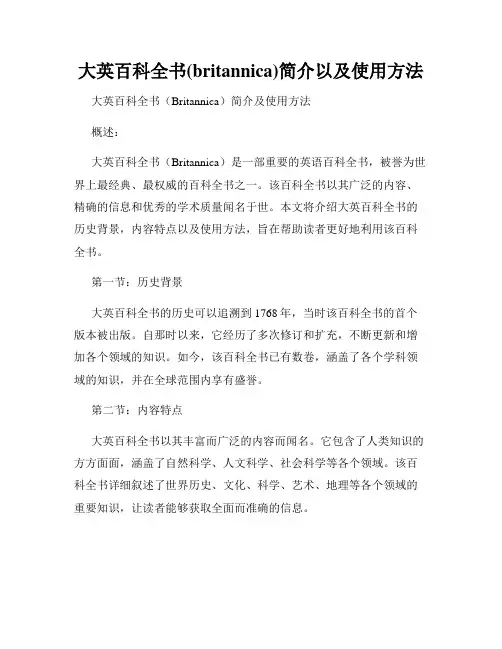
大英百科全书(britannica)简介以及使用方法大英百科全书(Britannica)简介及使用方法概述:大英百科全书(Britannica)是一部重要的英语百科全书,被誉为世界上最经典、最权威的百科全书之一。
该百科全书以其广泛的内容、精确的信息和优秀的学术质量闻名于世。
本文将介绍大英百科全书的历史背景,内容特点以及使用方法,旨在帮助读者更好地利用该百科全书。
第一节:历史背景大英百科全书的历史可以追溯到1768年,当时该百科全书的首个版本被出版。
自那时以来,它经历了多次修订和扩充,不断更新和增加各个领域的知识。
如今,该百科全书已有数卷,涵盖了各个学科领域的知识,并在全球范围内享有盛誉。
第二节:内容特点大英百科全书以其丰富而广泛的内容而闻名。
它包含了人类知识的方方面面,涵盖了自然科学、人文科学、社会科学等各个领域。
该百科全书详细叙述了世界历史、文化、科学、艺术、地理等各个领域的重要知识,让读者能够获取全面而准确的信息。
大英百科全书还以其精确的信息而备受推崇。
它的编辑团队由一些学术界的著名专家组成,他们对所写内容进行严格的审核和核实,确保了百科全书中的信息的可靠性和准确性。
此外,大英百科全书还具有卓越的学术质量。
它在撰写和编辑过程中遵循严格的学术标准,确保了文字的规范性、一致性和权威性。
因此,该百科全书成为了众多学者、研究人员和学生们的重要参考资料。
第三节:使用方法使用大英百科全书可以帮助读者获得全面而准确的知识。
以下是几种使用方法:1. 主题搜索:读者可以首先确定自己感兴趣的主题,然后在百科全书中进行相关的搜索。
通过主题搜索,读者可以找到相关的文章、定义、人物传记等内容,深入了解特定领域的知识。
2. 交叉引用:大英百科全书内的条目之间经常存在交叉引用。
读者可以通过查看相关条目,获得深入的了解和更全面的视角。
这也有助于拓展知识范围并建立知识之间的关联。
3. 更新订阅:大英百科全书不断更新和修订其内容,以保持知识的时效性。

您的⼤英百科学术版Bri t annica Academic ⼊⻔指南。
使⽤指南您可以轻松访问备受赞誉的《⼤英百科全书》和⻙⽒⼤词典以及许多其他研究⼯具所提供的⼤量⽂章和多媒体。
欢迎academic .eb .com欢迎订阅⼤英百科学术版Bri t annica Academic⼤英百科学术版为进⾏全⾯的跨学科研究提供了所有必要条件。
在不同领域的诺⻉尔奖获得者,历史学家,专业顾问,教授和其他著名专家的贡献下,⼤英百科学术版以客观公正的国际化视⻆和洞察⼒提供⽆可⽐拟的可靠信息。
⾸⻚搜索栏⽬在搜索栏⽬在输⼊关键词进⾏搜索。
M y Research轻松地编辑,整理,保存和共享您喜欢的资料内容。
EBSCO 杂志/刊物点击查询数千则杂志和学术期刊⽂章。
⻙⽒⾼校⼤辞典Merriam-Webs t er’sCollegia t e Dic t ionar y全美最⼤,最全⾯的权威英语词典。
“世界地图集”(World A t las) 使您可以浏览世界各国的统计数据和相关内容。
使⽤“⽐较国家”(Compare Co u n t ries ) 来发现任何两个国家之间的异同。
“全球数据集”(World Fac t book ) 提供了区域性的统计和分析数据。
访问内容使⽤⽂章和媒体浏览按类别浏览内容。
研究⼯具原始⽂献通过单击访问推荐的原始⽂献,包括信件,演讲,历史⽂档和其他原始材料的数字记录。
通过权威媒体的每⽇新闻源,随时关注全球头条新闻。
新闻⾸⻚浏览⽂章和媒体在主⻚点击⽂章浏览(Ar t icle Bro w se)或媒体浏览(Media Bro w se)可让您按主题和⼦主题深⼊探索Bri t annica Academic的内容。
⼈物传记点击“传记”(Biographies)标签,按性别,时代,国籍及其专业领域搜索和浏览名⼈传记。
您还可以通过主⻚上的“传记”(Biographies)链接进⼊。
"全球数据集" (The World Fac t book ) 涵括了250多个单独的国家/地区的数据⻚⾯。
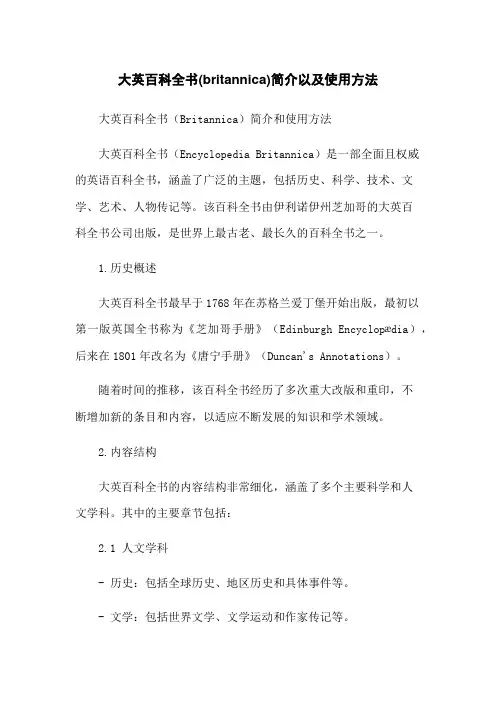
大英百科全书(britannica)简介以及使用方法大英百科全书(Britannica)简介和使用方法大英百科全书(Encyclopedia Britannica)是一部全面且权威的英语百科全书,涵盖了广泛的主题,包括历史、科学、技术、文学、艺术、人物传记等。
该百科全书由伊利诺伊州芝加哥的大英百科全书公司出版,是世界上最古老、最长久的百科全书之一。
1.历史概述大英百科全书最早于1768年在苏格兰爱丁堡开始出版,最初以第一版英国全书称为《芝加哥手册》(Edinburgh Encyclopædia),后来在1801年改名为《唐宁手册》(Duncan's Annotations)。
随着时间的推移,该百科全书经历了多次重大改版和重印,不断增加新的条目和内容,以适应不断发展的知识和学术领域。
2.内容结构大英百科全书的内容结构非常细化,涵盖了多个主要科学和人文学科。
其中的主要章节包括:2.1 人文学科- 历史:包括全球历史、地区历史和具体事件等。
- 文学:包括世界文学、文学运动和作家传记等。
- 艺术:包括绘画、雕塑、音乐、戏剧等艺术领域的介绍和评论。
- 哲学:涵盖哲学思想、学派和重要哲学家的介绍。
- 宗教:包括世界主要宗教的介绍和宗教历史。
- 语言学:包括语言学基础知识、语言分类和语言学家的介绍。
- 社会学:涵盖社会学理论和研究方法,以及社会学家的介绍。
- 民族学:包括世界各地区的民族和文化群体的介绍。
2.2 科学学科- 物理学:包括基本物理学原理、实验和重要物理学家的介绍。
- 化学:介绍化学基础理论、化学元素和化学反应等。
- 生物学:涵盖生命科学的不同方面,包括动物学、植物学和人类生物学等。
- 天文学:介绍天文学基础知识、星系和宇宙的结构等。
- 地球科学:包括地质学、气象学和地球物理学等。
- 数学:涵盖基本数学知识、数学定理和数学家的介绍。
- 计算机科学:介绍计算机科学原理、编程和网络技术等。
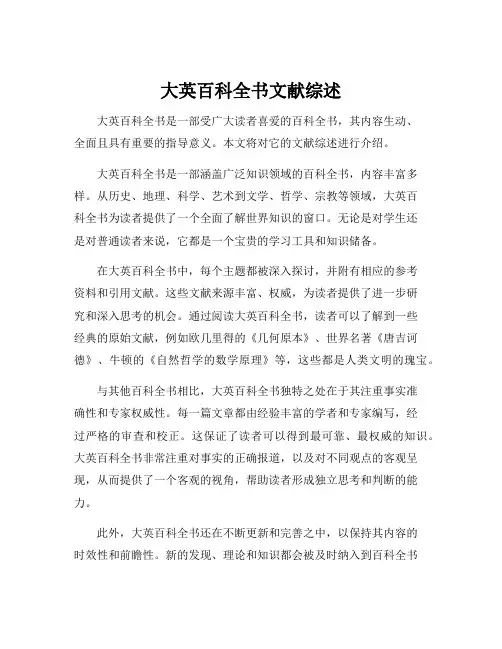
大英百科全书文献综述大英百科全书是一部受广大读者喜爱的百科全书,其内容生动、全面且具有重要的指导意义。
本文将对它的文献综述进行介绍。
大英百科全书是一部涵盖广泛知识领域的百科全书,内容丰富多样。
从历史、地理、科学、艺术到文学、哲学、宗教等领域,大英百科全书为读者提供了一个全面了解世界知识的窗口。
无论是对学生还是对普通读者来说,它都是一个宝贵的学习工具和知识储备。
在大英百科全书中,每个主题都被深入探讨,并附有相应的参考资料和引用文献。
这些文献来源丰富、权威,为读者提供了进一步研究和深入思考的机会。
通过阅读大英百科全书,读者可以了解到一些经典的原始文献,例如欧几里得的《几何原本》、世界名著《唐吉诃德》、牛顿的《自然哲学的数学原理》等,这些都是人类文明的瑰宝。
与其他百科全书相比,大英百科全书独特之处在于其注重事实准确性和专家权威性。
每一篇文章都由经验丰富的学者和专家编写,经过严格的审查和校正。
这保证了读者可以得到最可靠、最权威的知识。
大英百科全书非常注重对事实的正确报道,以及对不同观点的客观呈现,从而提供了一个客观的视角,帮助读者形成独立思考和判断的能力。
此外,大英百科全书还在不断更新和完善之中,以保持其内容的时效性和前瞻性。
新的发现、理论和知识都会被及时纳入到百科全书中,以便读者获取最新的信息。
从而,它不仅是一个静态的知识存储库,更是一个与时俱进的学术工具。
综上所述,大英百科全书的文献综述既生动全面又具有指导意义。
它为读者提供了一个深入了解世界知识的窗口,通过优质的文献来源、准确的信息和权威的专家意见,帮助读者形成独立思考和判断的能力。
无论是学生还是普通读者,都可以从中获益匪浅。
1 1054, Schism ofalso called East–West Schismevent that precipitated the final separation between the Eastern Christian churches (led by the patriarch of Constantinople, Michael Cerularius) and the Western Church (led by Pope Leo IX). The mutual excommunications by the Pope and the Patriarch that year became a watershed in church history. The excommunications were not lifted until 1965, when Pope Paul VI and Patriarch Athenagoras, following their historic meeting in Jerusalem in 1964, presided over simultaneous ceremonies that revoked the excommunication decrees.The relation of the Byzantine Church to the Roman may be described as one of growing estrangement from the 5th to the 11th century. In the early church three bishops stood forth prominently, principally from the political eminence of the cities in which they ruled—the bishops of Rome, Alexandria, and Antioch. The transfer of the seat of empire from Rome to Constantinople and the later eclipse of Alexandria andAntioch as battlegrounds of Islam and Christianity promoted the importance of Constantinople. Concurrently, the theological calmness of the West, in contrast to the often violent theological disputes that troubled the Eastern patriarchates, strengthened the position of the Roman popes, who made increasing claims to preeminence. But this preeminence, or rather the Roman idea of what was involved in it, was never acknowledged in the East. To press it upon the Eastern patriarchs was to prepare the way for separation; to insist upon it in times of irritation was to cause a schism.The theological genius of the East was different from that of the West. The Eastern theology had its roots in Greek philosophy, whereas a great deal of Western theology was based on Roman law. This gave rise to misunderstandings and at last led to two widely separate ways of regarding and defining one important doctrine—the procession of the Holy Spirit from the Father or from the Father and the Son—with the Roman churches, without consulting the East, incorporating the Son into their creed. The Eastern churches alsoresented the Roman enforcement of clerical celibacy, the limitation of the right of confirmation to the bishop, and the use of unleavened bread in the Eucharist.Political jealousies and interests intensified the disputes; and at last, after many premonitory symptoms, the final break came in 1054, when Pope Leo IX struck at Michael Cerularius and his followers with an excommunication and when the Patriarch retaliated with a similar excommunication. There had been mutual excommunications before, but they had not resulted in permanent schisms. At the time there seemed possibilities of reconciliation, but the rift grew wider; in particular, the Greeks were bitterly antagonized by such events as the Latin capture of Constantinople in 1204. Western pleas for reunion (on Western terms), such as those at the Council of Lyon (1274) or the Council of Ferrara-Florence (1439), were rejected by the Byzantines. The schism has never been healed.2 12-tone musiclarge body of music, written roughly since World War I, that uses the so-called 12-tone method or technique of composition. The Austrian-born composer Arnold Schoenberg is credited with the invention of this technique, although other composers (e.g., the American composer Charles Ives and the Austrian Josef Hauer) anticipated Schoenberg's invention by writing music that in a few respects was similar technically to his 12-tone music.Between 1912 and 1922 Schoenberg came to realize that he was searching for a new method of composition that would provide a new basis for musical structure to replace the old basis of tonality, which he felt was being stretched and distorted too much to remain a unifying structural principle. Instead of using 1 or 2 tones as main points of focus for an entire composition (as key centres in tonal music), Schoenberg suggested using all 12 tones “related only to one another.” In such a system, unlike tonality, no notes would predominate as focal points, nor would any hierarchy of importance be assigned to the individual tones.The new unifying principle in composition would then arise from the particular order given to a collection of the 12 tones, an order that would be different for each composition. The basic order for any one composition came to be known as its basic set, its 12-tone row, or its 12-tone series, all of which terms are synonymous. The basic set for Schoenberg's Wind Quintet (1924) is E–G–A–B–C–C–B–D–E–F–A –F; for his String Quartet No. 4 (1936) it is D–C –A–B–F–E–E–C–A–G–F–B.The basic set is not a theme, for it has no specific shape, rhythm, or loudness. It is a backbone, a musical idea that permeates the composition in which it is used. Because of the various principles of composing and manipulating the basic set recognized by Schoenberg and others, it is not often possible nor even desirable to hear the basic set when the composition is performed. This situation has led many people to attack Schoenberg's method as unmusical and as mathematical madness. Such views seem unjustifiable, because, as Schoenberg pointed out, his method specifies only a tiny fraction of the total nature of acomposition—certainly no more than composing with tonality specifies.Schoenberg's best-known pupils were the Austrian composers Anton von Webern and Alban Berg, each of whom wrote 12-tone music. Neither used the idea of the basic set in the same manner as Schoenberg did, and their music differs greatly in many respects from each other's and from Schoenberg's. Other important composers include the Russian-born Igor Stravinsky, the American Roger Sessions, the Austrian-born Ernst Krenek, the Italian Luigi Dallapiccola, and the German Hans Werner Henze. Many, such as Stravinsky (who had earlier criticized the approach severely) and Sessions, began writing 12-tone music after composing muchnon-12-tone music.Some composers also have used some of the notions behind the basic set while simultaneously writing tonal music; among them are Schoenberg himself, the Austrian-born Ernst Toch, the American Walter Piston, and the Russian Dmitry Shostakovich. The American composer Benjamin Johnston combined principles of 12-tone music withmicrotonality (use of intervals smaller than whole tones or semitones). There are no sufficient analytic techniques used by musicians in understanding 12-tone music, which is partly why it remains not very well understood as a total musical phenomenon by composers, performers, and listeners alike. Twelve-tone music is an example of serialism (q.v.) in music.3 1763, Proclamation ofproclamation declared by the British crown at the end of the French and Indian War in North America, mainly intended to conciliate the Indians by checking the encroachment of white settlers on their lands. After Indian grievances had resulted in the start of Pontiac's War (1763–64), British authorities determined to subdue intercolonial rivalries and abuses by dealing with Indian problems as a whole. To this end, the proclamation organized new British territories in America—the provinces of Quebec, East and West Florida, and Grenada (in the Windward Islands)—and a vast British-administered Indian reservation west of the Appalachians, from south of Hudson Bay to north of the Floridas. It forbade all white settlement on Indian territory, ordered those settlers already there to withdraw, and strictly limited future settlement. For the first time in the history of European colonization in the New World, the proclamation formalized the concept of Indian land titles, prohibiting issuance of patents to any lands claimed by a tribe unless the Indian title had first been extinguished by purchase or treaty.Although not intended to alter western boundaries, the proclamation was nevertheless offensive to the colonies as undue interference in their affairs. Treaties following Pontiac's War drew a more acceptable line of settlement (see Fort Stanwix, Treaties of), and the balance of territory north of the Ohio River was added to Quebec in 1774. The proclamation, however, failed to stem the westward movement of pioneers, whose disregard of its provisions evoked decades of continued Indian warfare throughout the area.4 1801, Concordat ofagreement reached on July 15, 1801, between Napoleon Bonaparte and papal and clerical representatives in both Rome and Paris, defining the status of the Roman Catholic Church in France and ending the breach caused by the church reforms and confiscations enacted during the French Revolution. The Concordat was formally promulgated on Easter day, 1802.In the agreement the First Consul (Napoleon) was given the right to nominate bishops; the bishoprics and parishes were redistributed; and the erection of seminaries was allowed. The Pope (Pius VII) condoned the actions of those who had acquired church property, and by way of compensation the government engaged to give the bishops and curés suitable salaries. The government added to it unilateral provisions of Gallican tendencies, which were known as the Organic Articles. After having been the law of the church of France for a century, it was denounced by the French government in 1905, when by the “Separation Law” church and state were sundered.5 1812, War ofIntroductionBattle between the frigates HMS Shannon and USS Chesapeake off Boston during the War …Theatre map for the War of 1812. Click on one hyperlink for a detailed map of the major battles in …(June 18, 1812–Feb. 17, 1815), conflict fought between the United States and Great Britain over British violations of U.S. maritime rights. It ended with the exchange of ratifications of the Treaty of Ghent.Major causes of the warThe tensions that caused the War of 1812 arose from the French revolutionary and Napoleonic Wars (1792–1815). During this nearly constant conflict between France and Britain, American interests were injured by each of the two countries' endeavours to block the United States from trading with the other.American shipping initially prospered from trade with the French and Spanish empires, although the British countered the U.S. claim that “free ships make free goods” with the belated enforcement of the so-called Rule of 1756 (trade not permitted in peacetime would not be allowed in wartime). The Royal Navy did enforce the act from 1793 to 1794, especially in the Caribbean Sea, before the signing of the Jay Treaty(Nov. 19, 1794). Under the primary terms of the treaty, American maritime commerce was given trading privileges in England and the British East Indies, Britain agreed to evacuate forts still held in the Northwest Territory by June 1, 1796, and the Mississippi River was declared freely open to both countries. Although the treaty was ratified by both countries, it was highly unpopular in the United States and was one of the rallying points used by the pro-French Republicans, led by Thomas Jefferson and James Madison, in wresting power from the pro-British Federalists, led by George Washington and John Adams.After Jefferson became president in 1801, relations with Britain slowly deteriorated, and systematic enforcement of the Rule of 1756 resumed after 1805. Compounding this troubling development, the decisive British naval victory at the Battle of Trafalgar (Oct. 21, 1805) and efforts by the British to blockade French ports prompted the French emperor, Napoleon, to cut off Britain from European and American trade. The Berlin Decree (Nov. 21, 1806) established Napoleon's Continental System, which impinged on U.S. neutral rights by designating ships that visited British ports as enemy vessels. The British responded with Orders in Council(Nov. 11, 1807) that required neutral ships to obtain licenses at English ports before trading with France or French colonies. In turn, France announced the Milan Decree (Dec. 17, 1807), which strengthened the Berlin Decreeby authorizing the capture of any neutral vessel that had submitted to search by the British. Consequently, American ships that obeyed Britain faced capture by the French in European ports, and if they complied with Napoleon's Continental System, they could fall prey to the Royal Navy.The Royal Navy's use of impressment to keep its ships fully crewed also provoked Americans. The British accosted American merchant ships to seize alleged Royal Navy deserters, carrying off thousands of U.S. citizens into the British navy. In 1807 the frigate H.M.S. Leopard fired on the U.S. Navy frigate Chesapeake and seized four sailors, three of them U.S. citizens. London eventually apologized for this incident, but it came close to causing war at the time. Jefferson, however, chose to exert economic pressure against Britain and France by pushing Congress in December 1807 to pass the Embargo Act, which forbade all export shipping from U.S. ports and most imports from Britain.The Embargo Act hurt Americans more than the British or French, however, causing many Americans to defy it. Just before Jefferson left office in 1809, Congress replaced the Embargo Act with the Non-Intercourse Act, which exclusively forbade trade with Great Britain and France. This measure also proved ineffective, and it was replaced by Macon's Bill No.2 (May 1, 1810) that resumed trade with all nations but stipulated that if either Britain or France dropped commercial restrictions, the United States would revive nonintercourse against the other. In August, Napoleon insinuated that he would exempt American shipping from the Berlin and Milan decrees. Although the British demonstrated that French restrictions continued, U.S. Pres. James Madison reinstated nonintercourse against Britain in November 1810, thereby moving one step closer to war.Britain's refusal to yield on neutral rights derived from more than the emergency of the European war. British manufacturing and shipping interests demanded that the Royal Navy promote and sustain British trade against Yankee competitors. The policy born of that attitude convinced many Americans that they were being consigned to a de facto colonial status. Britons, on the other hand, denounced American actions that effectively made the United States a participant in Napoleon's Continental System.Events on the U.S. northwestern frontier fostered additional friction. Indian fears over American encroachment coincidentally became conspicuous as Anglo-American tensions grew. Shawnee brothers Tecumseh and Tenskwatawa (The Prophet) attracted followers arising from this discontent and attempted to form an Indian confederation to counteract American expansion. Although Maj. Gen. Isaac Brock, the British commander of Upper Canada (modern Ontario), had orders to avoid worsening American frontier problems, American settlers blamed British intrigue forheightened tensions with Indians in the Northwest Territory. As war loomed, Brock sought to augment his meagre regular and Canadian militia forces with Indian allies, which was enough to confirm the worst fears of American settlers. Brock's efforts were aided in the fall of 1811, when Indiana territorial governor William Henry Harrison fought the Battle of Tippecanoe and destroyed the Indian settlement at Prophet's Town (near modern Battle Ground, Ind.). Harrison's foray convinced most Indians in the Northwest Territory that their only hope of stemming further encroachments by American settlers lay with the British. American settlers, in turn, believed that Britain's removal from Canada would end their Indian problems. Meanwhile, Canadians suspected that American expansionists were using Indian unrest as an excuse for a war of conquest.Under increasing pressure, Madison summoned the U.S. Congress into session in November 1811. Pro-war western and southern Republicans (War Hawks) assumed a vocal role, especially after Kentucky War Hawk Henry Clay was elected speaker of the House of Representatives. Madison sent a war message to the U.S. Congress on June 1, 1812, and signed the declaration of war on June 18, 1812. The vote seriously divided the House (79–49) and was gravely close in the Senate (19–13). Because seafaring New Englanders opposed the war, while westerners and southerners supported it, Federalists accused war advocates of expansionism under the ruse of protecting American maritime rights. Expansionism, however, was not as much a motive as was the desire to defend American honour. The United States attacked Canada because it was British, but no widespread aspiration existed to incorporate the region. The prospect of taking East and West Florida from Spain encouraged southern support for the war, but southerners, like westerners, were sensitive about the United States's reputation in the world. Furthermore, British commercial restrictions hurt American farmers by barring their produce from Europe. Regions seemingly removed from maritime concerns held a material interest in protecting neutral shipping. “Free trade and sailors' rights” was not an empty phrase for those Americans.The onset of war both surprised and chagrined the British government, especially because it was preoccupied with the fight against France. In addition, political changes in Britain had already moved the government to assume a conciliatory posture toward the United States. Prime Minister Spencer Perceval's assassination on May 11, 1812, brought to power a more moderate Tory government under Lord Liverpool. British West Indies planters had been complaining for years about the interdiction of U.S. trade, and their growing influence, along with a deepening recession in Great Britain, convinced the Liverpool ministry that the Orders in Councilwere averse to British interests. On June 16, two days before the United States declared war, the Orders were suspended.Some have viewed the timing of this concession as a lost opportunity for peace because slow transatlantic communication meant a month's delay in delivering the news to Washington. Yet, because Britain's impressment policy remained in place and frontier Indian wars continued, in all likelihood the repeal of the Orders alone would not have prevented war.WarNeither the British in Canada nor the United States were prepared for war. Americans were inordinately optimistic in 1812. William Eustis, the U.S. secretary of war, stated, “We can take the Canadas without soldiers, we have only to send officers into the province and the people…will rally round our standard.” Henry Clay said that “the militia of Kentucky are alone competent to place Montreal and Upper Canada at your feet.” And Thomas Jefferson famously wroteThe acquisition of Canada this year, as far as the neighborhood of Quebec, will be a mere matter of marching, and will give us experience for the attack of Halifax the next, and the final expulsion of England from the American continent.The death of British commander Isaac Brock at the Battle of Queenston Heights (Oct. 13, 1812), …The British government, preoccupied with the European conflict, saw American hostilities as a bothersome distraction, resulting in a paucity of resources in men, supplies, and naval presence until late in the event. As the British in Canada conducted operations under the shadow of scarcity, their only consolation was an American military malaise. Michigan territorial governor William Hull led U.S. forces into Canada from Detroit, but Isaac Brock and Tecumseh's warriors chased Hull back across the border and frightened him into surrendering Detroit on Aug. 16, 1812, without firing a shot—behaviour that Americans and even Brock's officers found disgraceful. The Northwest subsequently fell prey to Indian raids and British incursions led by Maj. Gen. Henry Procter. Hull's replacement, William Henry Harrison, could barely defend a few scattered outposts. On the northeastern border, U.S. Brig. Gen. Henry Dearborn could not attack Montreal because ofuncooperative New England militias. U.S. forces under Stephen van Rensselaer crossed the Niagara River to attack Queenston on Oct. 13, 1812, but ultimately were defeated by a stiff British defense organized by Brock, who was killed during the fight. U.S. Gen. Alexander Smyth's subsequent invasion attempts on the Niagara were abortive fiascoes.In 1813, Madison replaced Dearborn with Maj. Gens. James Wilkinson and Wade Hampton, an awkward arrangement made worse by a complicated invasion plan against Montreal. The generals refused to coordinate their efforts, and neither came close to Montreal. To the west, however, American Oliver Hazard Perry's Lake Erie squadron won a great victory off Put-in-Bay on Sept. 10, 1813, against Capt. Robert Barclay. The battle opened the way for Harrison to retake Detroit and defeat Procter's British and Indian forces at the Battle of the Thames (Oct. 5). Tecumseh was killed during the battle, shattering his confederation and the Anglo-Indian alliance. Indian anger continued elsewhere, however, especially in the southeast where the Creek War erupted in 1813 between Creek Indian nativists (known as Red Sticks) and U.S. forces. The war also took an ugly turn late in the year, when U.S. forces evacuating the Niagara Peninsula razed the Canadian village of Newark, prompting the British commander, Gordon Drummond, to retaliate along the New York frontier, leaving communities such as Buffalo in smoldering ruins.Early in the war, the small U.S. navy boosted sagging American morale as officers such as Isaac Hull, Stephen Decatur, and William Bainbridge commanded heavy frigates in impressive single-ship actions. The British Admiralty responded by instructing captains to avoid individual contests with Americans, and within a year the Royal Navy had blockaded important American ports, bottling up U.S. frigates. British Adm. George Cockburn also conducted raids on the shores of Chesapeake Bay. In 1814, Britain extended its blockade from New England to Georgia, and forces under John Sherbrooke occupied parts of Maine.By 1814, capable American officers, such as Jacob Brown, Winfield Scott, and Andrew Jackson, had replaced ineffective veterans from the American Revolution. On March 27, 1814, Jackson defeated the Red Stick Creeks at the Battle of Horseshoe Bend in Alabama, ending the Creek War. That spring, after Brown crossed the Niagara River and took Fort Erie, Brig. Gen. Phineas Riall advanced to challenge the American invasion, but American regulars commanded by Scott repulsed him at the Battle of Chippewa(July 5, 1814). In turn, Brown retreated when Commodore Isaac Chauncey's Lake Ontario squadron failed to rendezvous with the army, and during this retrograde the war's costliest engagement occurred at the Battle of Lundy's Lane (July 25). Riall, reinforced by Drummond, fought the Americans to a bloody stalemate in which each side suffered more than 800 casualties before Brown's army withdrew to Fort Erie.∙Battle of Plattsburgh Bay, Sept. 11, 1814, in which a British squadron under George Downie was …∙G. Thompson's wood engraving of ―The Burning of the City of Washington‖ during the War …In 1814, Napoleon's defeat allowed sizable British forces to come to America. That summer, veterans under Canadian governor-general George Prevost marched south along the shores of Lake Champlain into New York, but they returned to Canada after Thomas Macdonough defeated a British squadron under Capt. George Downie at the Battle of Plattsburgh Bay (see Plattsburgh), N.Y. (Sept. 11, 1814). British raids in Chesapeake Bay directed by Adm. Alexander Cochrane were more successful. British Gen. Robert Ross captured Washington (August 24) and burned government buildings, including the United States Capitol and the Executive Mansion (now known as the White House). The British justified this action as retaliation for the American destruction of York (modern Toronto), the capital of Upper Canada, the previous year. The British assault on Baltimore (September 12–14) foundered when Americans fended off an attack at Northpoint and withstood the naval bombardment of Fort McHenry, an action that inspired Francis Scott Key's "Star-Spangled Banner." Ross was killed at Baltimore, and the British left Chesapeake Bay to plan an offensive against New Orleans.Meanwhile, New England Federalists, angry about the war's effect on commerce, gathered at Hartford, Conn., to propose ways of redressing their grievances. Convening from Dec. 15, 1814 to Jan. 5, 1815, the Hartford Convention adopted moderate resolutions, but its mere existence prompted other parts of the country to question New England's patriotism and Federalist loyalty, spelling eventual doom to the party.Final stages of the war and the aftermathImmediately after the war started, the tsar of Russia offered to mediate. London refused, but early British efforts for an armistice revealed a willingness to negotiate so that Britain could turn its full attention to Napoleon. Talks began at Ghent (in modern Belgium) in August 1814, but, with France defeated, the British stalled while waiting for news of a decisive victory in America. Most Britons were angry that the United States had become an unwitting ally of Napoleon, but even that sentiment was half-hearted among a people who had been at war in Europe for more than 20 years. Consequently, after learning of Plattsburgh and Baltimore and upon the advice of the Duke of Wellington, commander of the British army at the Battle of Waterloo, the British government moved to make peace. Americans abandoned demands about ending impressment (the end of the European war meant its cessation anyway), and the British dropped attempts to change the Canadian boundary and establish an Indian barrier state in the Northwest. The commissioners signed a treaty on Dec. 24, 1814. Based on the status quo antebellum (the situation before the war), the Treaty of Ghent did not resolve the issues that had caused the war, but at that point Britain was too weary to win it, and the U.S. government deemed not losing it a tolerable substitute for victory. Nevertheless, many Americans became convinced that they had won the contest.Unaware of the treaty, British forces under Edward Pakenham assaulted New Orleans on Jan. 8, 1815, and were soundly defeated by Andrew Jackson's ragtag army, an event that contributed to the notion of a U.S. triumph. The unanimous ratification by the U.S. Senate of the Treaty of Ghent and the celebrations that followed cloaked the fact that the United States had achieved none of its objectives.Contention in the United States had hobbled the war effort, and domestic disaffection had menaced the Union, but after the war a surge of patriotism inspired Americans to pursue national goals. Contrary to American expectations, Canada remained British and eventually developed its own national identity, partly from pride over repulsing U.S. invasions. Meanwhile, Britain's influence among the northwestern Indians was forever ended, and American expansion in that region proceeded unchecked. In the South, the Creek War opened a large part of that region for settlement and led to the events that persuaded Spain to cede Florida to the United States in 1821.The most enduring international consequence of the war was in the arbitration clauses of Ghent, perhaps the treaty's most important feature. Its arrangements to settle outstanding disagreements established methodsthat could adapt to changing U.S. administrations, British ministries, and world events. There lay the seeds of an Anglo-American comity that would weather future disagreements to sustain the longest unfortified border in the world.David S. HeidlerJeanne T. HeidlerAdditional ReadingDavid S. Heidler and Jeanne T. Heidler, The War of 1812 (2002), contains essays that examine the causes of the war, the diplomatic ramifications, and the military conduct of the conflict. David S. Heidler and Jeanne T. Heidler(eds.), Encyclopedia of the War of 1812(1997, reissued 2004), is the only all-inclusive reference work on the war that examines its causes as well as the social, military, political, and diplomatic facets of the war.Donald R. Hickey, The War of 1812: A Forgotten Conflict (1989, reissued 1995), is a good one-volume narrative of the war that emphasizes the politics of the clash. J.C.A. Stagg, Mr. Madison's War: Politics, Diplomacy, and Warfare in the Early American Republic, 1783–1830(1983), is an exemplary examination of the civil-military relations in the United States during the war.Richard V. Barbuto, Niagara 1814: America Invades Canada (2000), offers an excellent analysis of this pivotal theatre of the war. J. Mackay Hitsman, The Incredible War of 1812: A Military History, rev. ed. updated by Donald E. Graves (1999), examines the war on the border from the Canadian viewpoint.Pierre Berton, Flames Across the Border: The Canadian-American Tragedy, 1813–1814(1981, reissued 2001), views the beginning of Canadian national identity as originating in the war on the border.Robert Gardner (ed.), The Naval War of 1812 (1998), provides some of the latest scholarship on the naval war. C. Edward Skeen, Citizen Soldiers in the War of 1812 (1999), examines the role of militia in the war.Sandy Antal, A Wampum Denied: Procter's War of 1812(1997), is an interesting revisionist examination of Britain's war in the Northwest that sees British efforts there as largely successful.。
【内容简介】本书又称《大英百科全书》,第一版于1768-1771年创始于苏格兰爱丁堡。
20世纪初该书版权归美国人所有,现由总部设在美国芝加哥的不列颠百科全书出版公司。
该书素以学术性强、权威性高著称,也侵泄 督缱钍煜さ挠⑽陌倏迫 椤8檬榈?5版于1974年问世,共30卷,1985年增至32卷,分为4个部分:《索引》2卷;《百科类目》1卷,是全书知识分类目录;《百科简编》12卷,有短条目80000余条,又是一部可供单独使用的简明百科全书;《百科详编》17卷,有长条目670余条,系统地介绍各学科知识、重要人物、历史、地理等。
该书每年增补和修改部分条目,出一新版,同时出版《年鉴》1卷。
不列颠百科全书》国际中文版是中国大百科全书出版和美国不列颠百科全书公司最新合作的新版本。
这是一部大型的综合性参考工具书。
全书共20卷,1-18卷为条目正文,19-20卷为索引;共收条目81600余条,附有图片15300余幅,地图250幅;总字数约4300万字。
前言:《不列颠百科全书》国际中文版是中国大百科全书出版社和美国不列颠百科全书公司最新合作的新版本。
这是一部大型的综合性参考工具书。
全书共20卷,1~18卷为条目正文,19~20卷为索引;共收条目81600余条,附有图片15300余幅,地图250幅;总字数约4300万字。
《不列颠百科全书》又称《大英百科全书》,第一版于1768~1771年创始于苏格兰爱丁堡。
20世纪初该书版权归美国人所有,现由总部设在美国芝加哥的不列颠百科全书公司出版。
该书素以学术性强、权威性高著称,也是中国知识界最熟悉的英文百科全书。
该书第15版于1974年问世,共30卷,1985年增至32卷,分为4个部分:《索引》2卷;《百科类目》1卷,是全书知识分类目录;《百科简编》12卷,有短条目80000 余条,又是一部可供单独使用的简明百科全书;《百科详编》17卷,有长条目670余条,系统地介绍各学科知识、重要人物、历史、地理等。